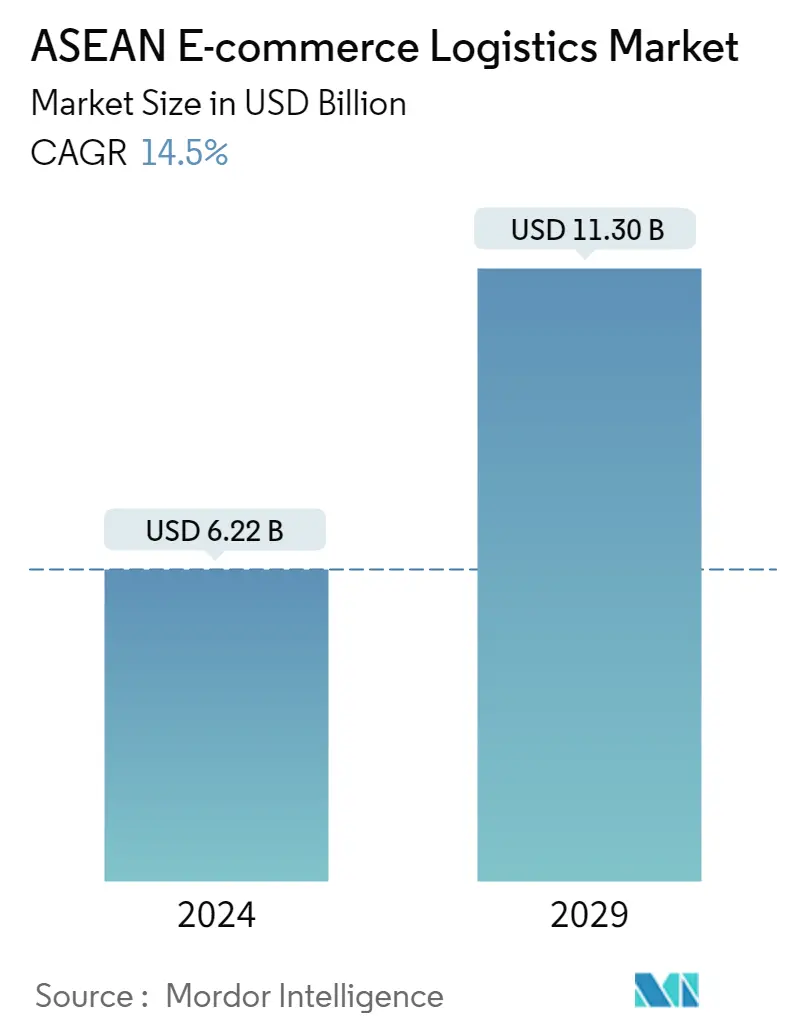Market Size of ASEAN E-commerce Logistics Industry

| Study Period | 2019 - 2029 |
| Base Year For Estimation | 2023 |
| Market Size (2024) | USD 6.22 Billion |
| Market Size (2029) | USD 11.30 Billion |
| CAGR (2024 - 2029) | 14.50 % |
| Market Concentration | Low |
Major Players
*Disclaimer: Major Players sorted in no particular order |
ASEAN E-commerce Logistics Market Analysis
The ASEAN E-commerce Logistics Market size is estimated at USD 6.22 billion in 2024, and is expected to reach USD 11.30 billion by 2029, growing at a CAGR of 14.5% during the forecast period (2024-2029).
When COVID-19 caused a surge in e-commerce throughout Southeast Asia, delivery companies struggled to sustain and expand their success. Southeast Asia's internet retail value increased from USD 495 billion to an estimated USD 581 million. Warehouses were typically 1,000 sq. mt. in size, but demand was for multi-level warehouses that could be 10,000 or 15,000 sq. mt.
Southeast Asia is poised for rapid growth in e-commerce. Five Southeast Asian countries are among the world's fastest-growing e-commerce markets, accounting for half of the top ten. Southeast Asia was previously an e-commerce laggard, digitally overshadowed by China and Japan. However, nearly all of them now have mobile devices and, as a result, internet access. The five countries' mobile penetration rates are all close to 100%.
According to industry sources, Malaysia has a population of 32.8 million people. E-commerce sales in the base year were USD 6.3 billion, up 15% from the previous year. Shopee is the most popular marketplace, followed by PGMall, a local platform that collaborates with JD. The most popular marketplaces are JD, Shopee, and Lazada. The main product categories are electronics and personal care.
Even though the rapid growth of e-commerce is driving logistics development in this market, this remains a challenge for a few countries with complex topography in Southeast Asia. Logistics operation management is a challenge for e-commerce businesses. As economies recover from the global pandemic and income levels rise, the intra-Asian market is expected to expand, with a corresponding increase in demand for express logistics services propelled by the thriving e-commerce sector.
ASEAN E-commerce Logistics Industry Segmentation
E-commerce logistics refers to the transportation service provided to the online retail market. A complete background analysis of the ASEAN e-commerce logistics market, including the assessment of the economy and contribution of sectors in the economy, market overview, market size estimation for key segments, and emerging trends in the market segments, market dynamics, and geographical trends, and COVID-19 impact is included in the report.
The ASEAN E-commerce Logistics Market is segmented By Service (Transportation, The report covers the ASEAN E-commerce Logistics Market Size and statistics. The market is Segmented By Service (Transportation, Warehousing and Inventory Management, and Value-added Services (Labeling, Packaging, etc.)), Business (B2B and B2C), Destination (Domestic and International/Cross-border), Product (Fashion and Apparel, Consumer Electronics, Home Appliances, Furniture, Beauty and Personal Care Products, and Other Products (Toys, Food Products, etc.)), and Country (Singapore, Thailand, Vietnam, Indonesia, Malaysia, Philippines, and the Rest of ASEAN). The report offers the market size in value terms in USD for all the abovementioned segments.
| By Service | |
| Transportation | |
| Warehousing and Inventory Management | |
| Value-added Services (Labeling, Packaging, etc.) |
| By Business | |
| B2B (Business-to-Business) | |
| B2C (Business-to-Consumer) |
| By Destination | |
| Domestic | |
| International/Cross-border |
| By Product | |
| Fashion and Apparel | |
| Consumer Electronics | |
| Home Appliances | |
| Furniture | |
| Beauty and Personal Care Products | |
| Other Products (Toys, Food Products, etc.) |
| By Country | |
| Singapore | |
| Thailand | |
| Vietnam | |
| Indonesia | |
| Malaysia | |
| Philippines | |
| Rest of the ASEAN |
ASEAN E-commerce Logistics Market Size Summary
The ASEAN e-commerce logistics market is experiencing significant growth, driven by the rapid expansion of e-commerce across Southeast Asia. This region, once lagging in digital commerce, is now home to some of the world's fastest-growing e-commerce markets, with nearly universal mobile penetration facilitating increased internet access. The surge in online shopping has created a robust demand for logistics services, prompting companies to invest in expanding and enhancing their logistics networks. Despite challenges such as complex topography and infrastructure gaps, the market is poised for substantial growth, supported by rising income levels and the increasing popularity of digital payments. Key product categories driving this growth include electronics and personal care items, with platforms like Shopee, JD, and Lazada leading the market.
The logistics landscape in ASEAN is becoming increasingly competitive, with both local and international players vying for market share. Companies are strategically investing in regional logistics networks, including the establishment of new distribution centers and smart warehouses, to meet the growing demand for efficient logistics solutions. The market is also witnessing a trend towards outsourcing logistics operations to third-party providers to maintain cost competitiveness. Additionally, significant investments in infrastructure development, aimed at improving connectivity and supporting the transition to green energy, are expected to further bolster the e-commerce logistics sector. These developments present lucrative opportunities for logistics service providers to capitalize on the burgeoning e-commerce market in Southeast Asia.
ASEAN E-commerce Logistics Market Size - Table of Contents
-
1. MARKET INSIGHTS DYNAMICS
-
1.1 Current Market Scenario
-
1.2 Market Dynamics
-
1.2.1 Drivers
-
1.2.1.1 Growing E-commerce Sector
-
-
1.2.2 Restraints
-
1.2.2.1 Complicated Product Returns
-
-
1.2.3 Opportunities
-
1.2.3.1 Increasing Investments in Digital Infrastructure
-
-
-
1.3 Value Chain / Supply Chain Analysis
-
1.4 Porter's Five Forces Analysis
-
1.4.1 Threat of New Entrants
-
1.4.2 Bargaining Power of Buyers/Consumers
-
1.4.3 Bargaining Power of Suppliers
-
1.4.4 Threat of Substitute Products
-
1.4.5 Intensity of Competitive Rivalry
-
-
1.5 Insights into Technological Trends and Automation
-
1.6 Government Regulations and Initiatives
-
1.7 Supply Chain/Value Chain Analysis
-
1.8 Insights into the E-commerce Market
-
1.9 Spotlight - Key Hubs for E-commerce Logistics
-
1.10 Insights into Reverse/Return Logistics
-
1.11 Impact of COVID-19 on the Market
-
-
2. MARKET SEGMENTATION
-
2.1 By Service
-
2.1.1 Transportation
-
2.1.2 Warehousing and Inventory Management
-
2.1.3 Value-added Services (Labeling, Packaging, etc.)
-
-
2.2 By Business
-
2.2.1 B2B (Business-to-Business)
-
2.2.2 B2C (Business-to-Consumer)
-
-
2.3 By Destination
-
2.3.1 Domestic
-
2.3.2 International/Cross-border
-
-
2.4 By Product
-
2.4.1 Fashion and Apparel
-
2.4.2 Consumer Electronics
-
2.4.3 Home Appliances
-
2.4.4 Furniture
-
2.4.5 Beauty and Personal Care Products
-
2.4.6 Other Products (Toys, Food Products, etc.)
-
-
2.5 By Country
-
2.5.1 Singapore
-
2.5.2 Thailand
-
2.5.3 Vietnam
-
2.5.4 Indonesia
-
2.5.5 Malaysia
-
2.5.6 Philippines
-
2.5.7 Rest of the ASEAN
-
-
ASEAN E-commerce Logistics Market Size FAQs
How big is the ASEAN E-commerce Logistics Market?
The ASEAN E-commerce Logistics Market size is expected to reach USD 6.22 billion in 2024 and grow at a CAGR of 14.5% to reach USD 11.30 billion by 2029.
What is the current ASEAN E-commerce Logistics Market size?
In 2024, the ASEAN E-commerce Logistics Market size is expected to reach USD 6.22 billion.

